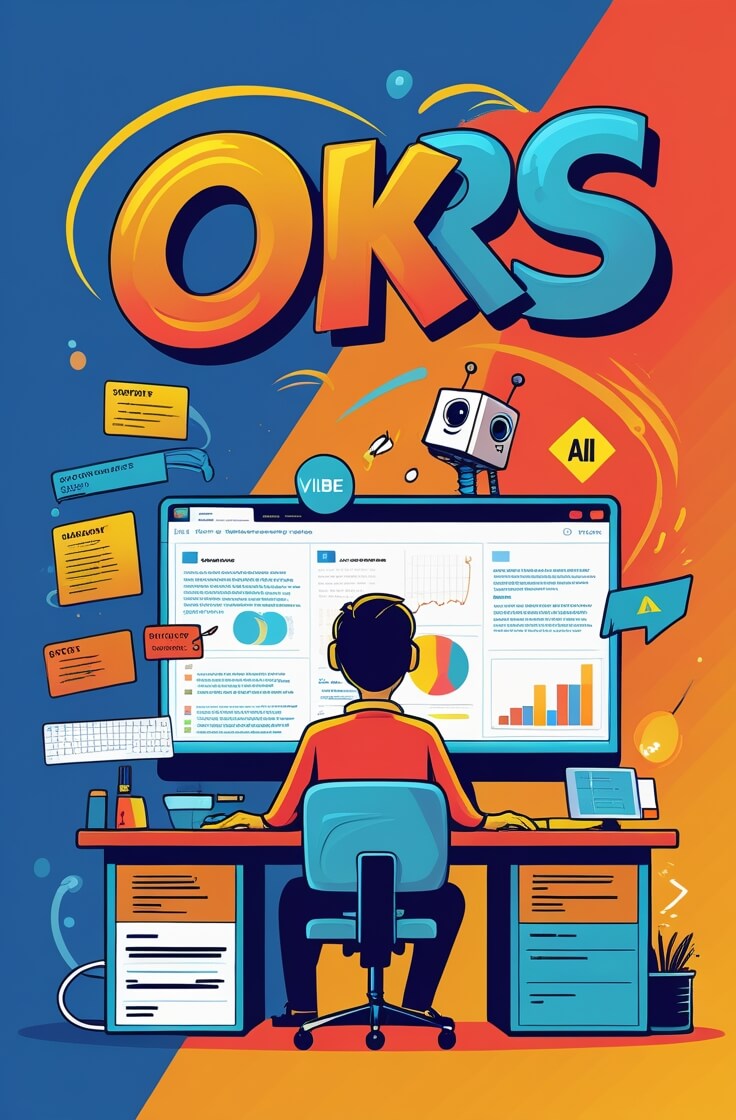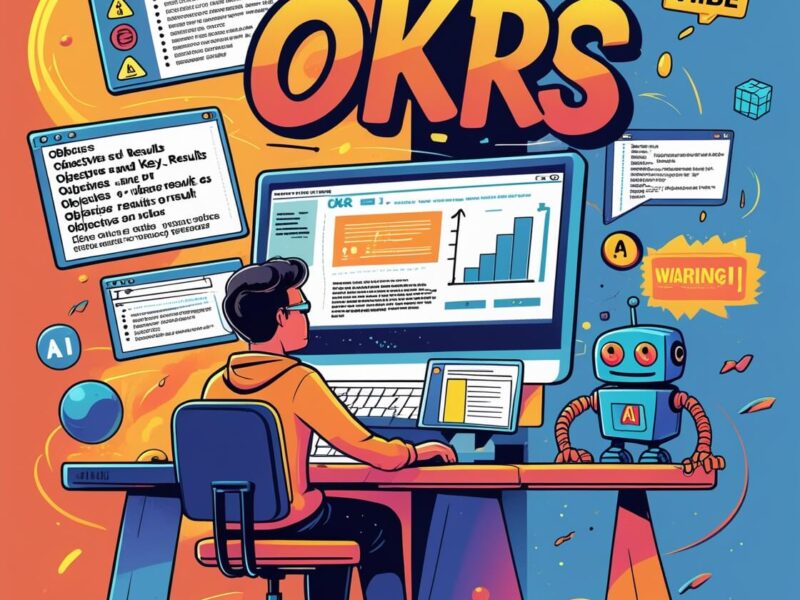The Strategic Art of Outcome-Focused Goal Setting
Introduction: The Power of Purposeful Goals
In today’s dynamic business landscape, organizations drowning in activity but starving for progress need a compass for meaningful achievement.
Objectives and Key Results (OKRs) emerge as that navigational tool—a goal-setting framework that transforms ambitions into measurable outcomes. Pioneered at Intel and popularized by Google, OKRs have become the operational heartbeat of organizations ranging from startups to the U.S. Navy.
Unlike traditional goal-setting methods, OKRs demand a fundamental shift: outcomes over outputs, impact over activity. As a UX designer and solutions architect who has implemented OKRs across Fortune 500 companies and agile startups, I’ve witnessed how this framework can align disjointed teams and catalyze breakthrough innovation—when executed correctly.
I. Deconstructing the OKR Anatomy
A. Objectives: The North Star
Objectives are qualitative, inspirational pillars that define where you want to go. As OKR evangelist Felipe Castro emphasizes, they should be “memorable, qualitative descriptions of what you want to achieve”.
Characteristics of strong Objectives:
Aspirational: Push teams beyond comfort zones (e.g., “Revolutionize mobile payment UX in Southeast Asia”)
Concrete: Avoid vague statements like “Improve customer service”
Aligned: Connect to organizational mission (e.g., Tesla’s “Accelerate the world’s transition to sustainable energy”)
Table: Objective Evaluation Checklist
| Trait | Strong Example | Weak Example |
|---|---|---|
| Specificity | “Dominate cloud gaming in Asia” | “Be the best in gaming” |
| Inspiration | “Make genomics accessible” | “Increase lab throughput” |
| Alignment | Ties directly to company vision | Generic industry goal |
B. Key Results: The Evidence of Progress
Key Results (KRs) are quantitative metrics measuring how you’ll know you’ve reached your Objective. Crucially:
Limit to 2–5 KRs per Objective—more dilutes focus
Must be measurable frequently (weekly/quarterly), not annually
Track outcomes, not activities: A fatal mistake is confusing outputs (tasks completed) with outcomes (impact created).
“If it can enter your backlog, it’s not an outcome.” — Outcome-Driven Framework Principle
Example Breakdown:
Objective: Reduce data errors in order processing system
❌ Output-Focused KR: “Install Vendor Package Release 10.0” (measures activity)
✅ Outcome-Focused KR: “Decrease data quality errors reported to support desk by 40%” (measures impact)
II. Why OKRs ≠ KPIs (and Why You Need Both)
A. The Critical Distinction
OKRs = Change agents: Drive strategic shifts (e.g., “Increase enterprise market share”)
KPIs = Health monitors: Track ongoing performance (e.g., “Monthly churn rate”)
Analogy: OKRs are your roadmap to a destination; KPIs are your dashboard gauges (fuel, speed, engine temp).
B. Integration in Practice
Objective: Improve customer satisfaction (OKR)
Key Result: Achieve NPS of 75 (OKR metric)
KPI: Weekly ticket resolution time (operational health)
Google’s Sustainability OKR:
Objective: “Reduce 50% of combined emissions by 2030”
Key Result: “Design offices to leading green building standards”
III. Engineering Effective Key Results: A Framework
A. The Outcome Test
Every KR must pass: “Does this measure a benefit created, not effort expended?”
✅ Benefit: “Decrease checkout abandonment by 25%”
❌ Effort: “Redesign checkout UI”
B. Leading vs. Lagging Indicators
Leading: Predictive metrics (e.g., “Increase free trial sign-ups by 30%”)
Lagging: Historical results (e.g., “Q4 revenue growth”)
Balance both for actionable insights.
C. Metric Mapping by Objective Type
Table: Objective-to-KR Alignment Guide
| Objective | Valid Key Results |
|---|---|
| Improve customer satisfaction | • Net Promoter Score (NPS) ≥ 70 • Support ticket resolution < 2 hrs • 20% reduction in churn |
| Scale system performance | • Handle 1M simultaneous users • Reduce critical alerts by 50% • Achieve 99.99% uptime |
| Increase recurring revenue | • $5M quarterly revenue • 100K new subscriptions • 15% expansion revenue growth |
IV. The Execution Architecture: Avoiding Common Pitfalls
A. The “Initiative Trap”
Per a global consumer goods VP: “70% of employee goals involve project deadlines—not strategic outcomes”. This creates a delivery culture, not an impact culture.
Antidote: Separate Initiatives (projects/tasks) from Key Results in documentation:
Objective: Accelerate mobile user growth
Key Result: Increase mobile app retention to 45% (outcome)
Initiative: Implement push notification system (output)
B. The Cascade Failure
Strict alignment (CEO KR → VP Objective) often creates bureaucratic rigidity. Instead, use directional alignment:
Company Objective: “Dominate cloud security market”
Engineering Objective: “Build zero-trust API infrastructure”
Not: “Support CEO KR#3”
C. Scoring & Cadence Best Practices
Scoring:
0.3 = Missed significantly
0.7 = Progressed meaningfully
1.0 = Achieved stretch target
Cadence:
Objectives: Annual/Quarterly
Key Results: Quarterly with weekly check-ins
V. Tool Ecosystem: Enabling OKR Success
A. Software Selection Criteria
Choose tools based on:
Integration depth (Jira, Slack, Salesforce)
UI clarity for company-wide transparency
AI capabilities for KR suggestions (e.g., Tability)
Real-time dashboards
B. Top Solutions by Use Case
Table: OKR Tool Matrix
| Organization Size | Recommended Tools | Key Strengths |
|---|---|---|
| Startups | Tability ($6/user), OKRs Tool (Free ≤10 users) | AI drafting, simplicity, speed |
| Enterprises | Profit.co ($9/user), Quantive | Cascading goals, custom analytics |
| Agile Teams | ClickUp, Asana | Task-KR linking, sprint integration |
“High performers use OKR tools 3× more than low performers.” — Global State of OKRs Report
VI. The UX of OKRs: Designing for Adoption
As architects of human-system interaction, we must reduce friction in OKR systems:
Visual Hierarchy: Use color-coded progress (🔴 behind, 🟢 on track)
Reductionism: Limit fields per OKR (Objective + 3 KRs max)
Feedback Loops: Integrate peer recognition features (e.g., Lattice)
Mobile-First: 78% of frontline managers access goals via phone
Case Study: A fintech client increased OKR adoption from 42% to 89% by:
Replacing 10-field forms with 3-field inputs
Adding Slack-based weekly check-ins
Displaying team OKRs on digital signage
Conclusion: From Frameworks to Transformation
Defining OKRs is less about filling templates and more about cultivating an outcome mindset. When Syracuse, New York implemented OKRs like “Achieve fiscal sustainability” with KRs such as “Reduce budget variance from 11% to 5%”, they didn’t just set goals—they installed a new operating system for decision-making.
The organizations that thrive will be those recognizing that:
Objectives are the compass—inspiring direction over incrementalism
Key Results are the evidence—demanding measurable change over activity
Tools are the enablers—connecting daily work to strategic intent
As John Doerr encapsulated in Measure What Matters: “Ideas are easy. Execution is everything.” OKRs provide the framework to bridge that chasm—when defined with precision, aligned with purpose, and embedded in your organizational DNA.
Recommended Resources


